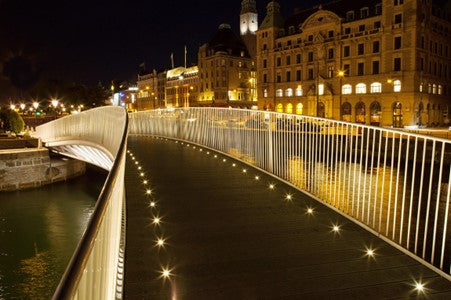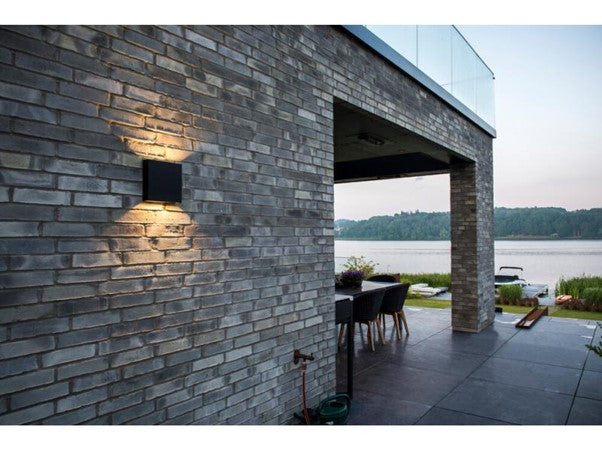Whether you want to create a perfect al-fresco atmosphere or increase your night time security, outdoor lighting is a helpful feature of any home. But do you know your bulkhead from your floodlight? Where should your lights be placed? Read on to learn more!
What Are My Outdoor Lighting Options?
Depending on the look that you’re going for, there are a lot of different options for lighting your outdoor space. Listed below are several great lighting option from LED Bulbs that will bring new life into any garden or outdoor space.
LED Bulkheads
An LED bulkhead is fixed to exterior walls or ceilings and is a great choice for navigating your outdoor spaces at night.
They generally aren’t as attractive as other options, but are a great choice for outdoor lighting that won’t upset your neighbours. They are not designed to flood your garden with light, but rather provide sufficient light for the immediate area.
They can be operated by switch or by sensor depending on your needs.
Floodlights
If you want to light a greater area (normally for security reasons), a floodlight is a great choice. They’re perfect for illuminating your whole garden or driveway, larger industrial units, lighting up car parks, and more.
Walkover Lights
A boring name for lights that can create a beautiful effect, walkover lights are lights that can handle the weight of people walking or even cars. They can turn your regular path into a magical walkway, level up your water feature, or simply make it easier to see your drive.

String Lights
Probably the most recognisable garden decorations, string lights come in a wide variety of shapes and colours. Whether you hang small lights in the trees or globe lights hanging from your pergola, they’re an effective way to create atmosphere in your space.
Wall Lights
Whether you’re looking for a classic or modern style, wall lights are a fantastic solution for lighting entrances and pathways. They can be fitted with sensors to only turn on when they detect movement, so you don’t have to worry about the local cats setting them off at night.
Wall lights don’t illuminate a wide area, as their beams are generally only angled up or down the wall (or both), but they’re a great choice for adding style or lighting a specific spot.
Where's the Best Place for My Outdoor Lights?
While it mainly depends on personal preference, some lights should be specifically placed to get the most out of them.
To illuminate a door with a wall light put the light 1.6m from ground level and 0.15m away from the door (if you only have 1 light, put it on the side with the handle)
Floodlights should be placed as high up on the wall as possible, ideally along the roofline, so they can reach further and avoid being tampered with.
Need Outdoor Lighting Inspiration?
- To make a pergola or seating area comfy and inviting, you can add string lights
- Wall lights that point upwards can highlight hanging baskets, house numbers, or entryways
- Use walkover lights or a spotlight to show off plants that you’re particularly fond of
- Line decking with lights to make it safer and useful for longer into the night


 GU10 LED Bulbs
GU10 LED Bulbs
 MR16 LED Bulbs
MR16 LED Bulbs
 GU4 LED Bulbs
GU4 LED Bulbs
 AR111 LED Bulbs
AR111 LED Bulbs
 G9 LED Bulbs
G9 LED Bulbs
 B22 LED Bulbs
B22 LED Bulbs
 B15 LED Bulbs
B15 LED Bulbs
 E27 LED Bulbs
E27 LED Bulbs
 E14 LED Bulbs
E14 LED Bulbs
 R7 LEDs
R7 LEDs
 LED Capsule Bulbs
LED Capsule Bulbs
 Golf Ball LED Bulbs
Golf Ball LED Bulbs
 LED Spotlights
LED Spotlights
 LED PAR Reflectors
LED PAR Reflectors
 GLS LED Bulbs
GLS LED Bulbs
 Candle LED Bulbs
Candle LED Bulbs
 LED Under Cabinet Lighting
LED Under Cabinet Lighting
 LED Tubes
LED Tubes
 LED Battens
LED Battens
 PL LED Bulbs
PL LED Bulbs
 LED Globe Bulbs
LED Globe Bulbs
 LED Floodlights
LED Floodlights
 Highbay Lights
Highbay Lights
 High Bay LED Bulbs
High Bay LED Bulbs
 LED Bulkheads
LED Bulkheads

 T8 LED Tubes
T8 LED Tubes
 Emergency Lighting
Emergency Lighting
 Site Lighting
Site Lighting
 Integrated LED Downlights
Integrated LED Downlights
 Non-Integrated Downlights
Non-Integrated Downlights
 Non Integrated Luminaires
Non Integrated Luminaires
 LED Wall Lights
LED Wall Lights
 LED Walkover Lights
LED Walkover Lights
 LED Garden Lights
LED Garden Lights
 Home Security Cameras
Home Security Cameras
 Home Security CCTV
Home Security CCTV
 Home Security Alarms
Home Security Alarms
 Doorbells
Doorbells
 Cabling & Accessories
Cabling & Accessories

 Sockets
Sockets
 Dimmer Switches
Dimmer Switches
 Light Switches
Light Switches
 Time Controllers
Time Controllers
 Downlight Accessories & Bezels
Downlight Accessories & Bezels
 LED Drivers
LED Drivers
 600 x 600 LED Panels
600 x 600 LED Panels
 1200 x 600 LED Panels
1200 x 600 LED Panels
 Mode
Mode




